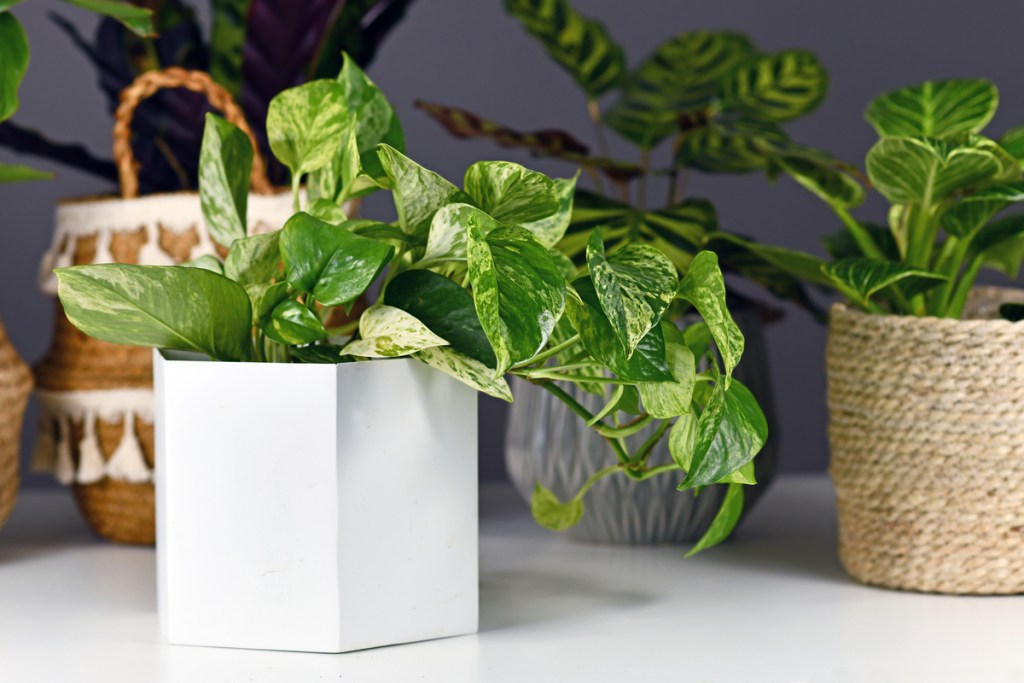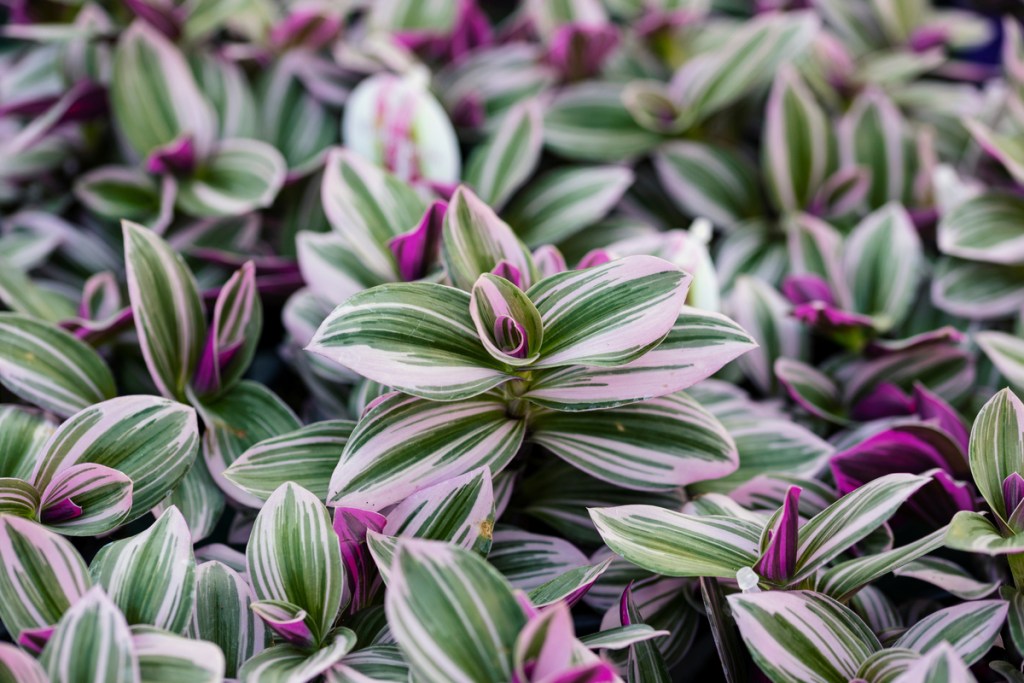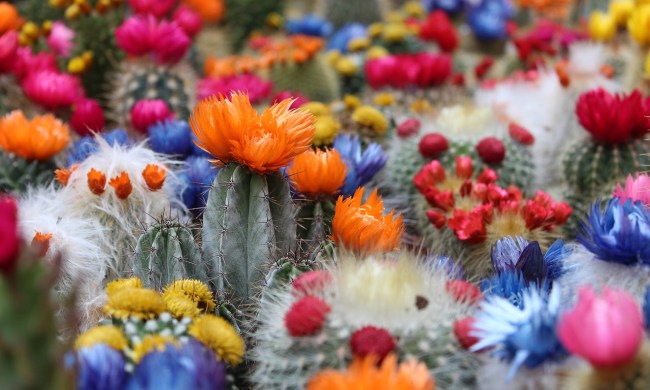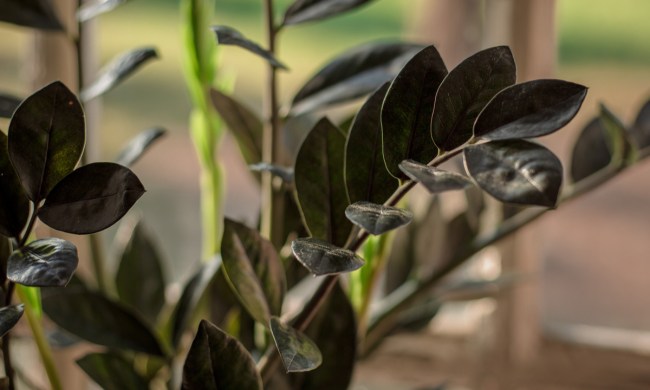Most houseplants are green, sure, but not all of them! Many indoor plants come with unique colors and patterns that can add visual interest to your space, giving you lush tropical vibes with splashes of cream, pink, purple, and many more. While some coveted variegated plants, such as the monstera Thai constellation, can cost an arm and a leg, there are definitely many accessible and affordable patterned plants out there! Ahead, we’ve rounded up a list of seven variegated houseplants that will add flair and excitement to your collection.

Marble queen pothos
The marble queen pothos resembles many coveted albino varieties, but it’s much more accessible and affordable. The medium-green leaves have specks and splashes of cream coloring for a lovely marbling effect. The gorgeous variegation doesn’t make this a difficult plant — it’s still as low maintenance as your typical jade or golden pothos! Let it dry out between waterings before you soak it. The soil should feel dry, and the leaves may feel slightly limp. To encourage growth, feed your plant with a mild diluted fertilizer throughout the growing season and give it plenty of bright indirect sunlight.
Ficus elastica ruby
The typical ficus elastica has striking dark green leaves, but if you’re into splashes of cream and pink, check out the ruby variety. The more bright indirect light that you give this plant, the deeper its gorgeous color will become. If you do give it lower light, it may revert to a green color with cream-colored edges. Other than sufficient sunlight, the ficus elastica ruby also appreciates drying out between waterings and weekly fertilizing during the growing season.
Polka dot plant
The cute polka dot plant features a base of dark green spots with splashes of pink and red. As you may have already guessed, the color stays vibrant with bright, indirect sunlight — just keep in mind that direct sunlight might scorch your leaves. While less high-maintenance than your typical ferns and calatheas, the polka dot plant does need consistent watering and high humidity. If you notice it getting leggy over time, prune it back so that it can grow back bushier.

Tradescantia nanouk
The gorgeous tradescantia nanouk consists of trailing striped leaves that flaunt a shimmery lilac color. Tradescantia do prefer consistent weekly watering and high humidity, so make sure that your plant is receiving the moisture that it needs to thrive. If you notice brown tips, you may want to use filtered water to water your plant and give it less direct sunlight.
Philodendron brasil
Philodendrons are right up there with pothos when it comes to low-maintenance trailing plants. The philodendron brasil has such stunning footage that it almost looks fake or painted on — each leaf is dark green with a bright neon yellow stripe down the middle. Its care requirements aren’t very particular, either. Allow the soil to dry out between waterings. It can go without fertilizing, but it’ll benefit from weekly or bi-monthly feedings with a diluted all-purpose fertilizer. To help it maintain its color, give it plenty of bright indirect light.
Dieffenbachia tropic snow
The dieffenbachia tropic snow is a tall, stunning plant with dark green leaves that flaunt creamy white centers. With well-draining soil, consistent watering, and bright indirect light, this variety of dieffenbachia can grow up to six feet tall. To encourage growth, fertilize your plant with diluted liquid fertilizer at half strength every month. If you notice browning tips, consider giving your plant more humidity or using filtered water.
Calathea white fusion
Calatheas generally have beautiful patterns on their leaves. One of our favorites is the calathea white fusion, which has signature glossy calathea foliage, but with white stripes that look like they were painted onto the leaves. The underside is a purple-pink color, and you may even find a wash of a similar lilac hue on some of the white parts. Airy soil that retains water well will be perfect for this variegated calathea. As with most prayer plants, the white fusion appreciates high humidity and consistently moist soil. To maintain its variegation, keep it in bright indirect light — just be careful not to scorch it in direct sunlight! With calatheas, you may want to use filtered water instead of tap water to prevent salt buildup, which can cause crispy leaf tips.
If you’re looking for a variegated houseplant, you’ll find plenty out there with gorgeous patterning and reasonable price tags. From the ficus elastica ruby to the philodendron brasil, there’s a whole world of lovely variegated plants to choose from. With any plant that features patterns and splashes of colors, bright indirect sunlight will be your best friend for maintaining the variegation. Consistent watering and fertilizer will also help with growth. Combine these care tips with patience, and you’ll have a thriving variegated plant in no time!



